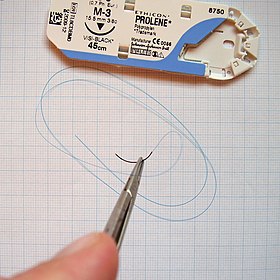Needles and Suture Thread
- Surgeons historically used reusable needles with separate suture thread.
- Swaged needles consist of a pre-packed needle attached to a specific length of suture thread.
- Atraumatic needles have a narrower suture end, reducing tissue trauma.
- Needles can be straight, various curved shapes, or compound curve.
Suture Materials
- Suture material can be absorbable or non-absorbable.
- Monofilament fibers have less tensile strength but create less tissue trauma.
- Polyfilament (braided) sutures have greater tensile strength but can cause greater tissue reaction.
- Natural absorbable materials include plain catgut, chromic catgut, and fast catgut.
Natural Absorbable Materials
- Plain catgut, chromic catgut, and fast catgut are produced from collagen extracted from bovine intestines.
- Plain Gut maintains strength for 7-10 days and degrades fully in 10 weeks.
- Chromic Gut maintains strength for 21-28 days and degrades fully in 16-18 weeks.
- Fast Gut is treated with heat for more rapid absorption and has a tensile strength of less than a week.
Absorbable vs Non-absorbable Sutures
- Absorbable sutures are degraded via proteolysis or hydrolysis and are used internally or for individuals unlikely to return for suture removal.
- Short-term wound outcomes are equivalent for absorbable and non-absorbable sutures.
- Natural absorbable materials have high tissue reactivity, while non-absorbable synthetic sutures have the lowest tissue reactivity.
- Non-absorbable sutures require removal, while absorbable sutures are not removed.
Suture Techniques
- Types of Stitches/Suturing Techniques: interrupted stitch, mattress stitch, continuous stitch, continuous locking stitch, chest drain stitch, corner stitch.
- Placement: mounting needle, pressing into flesh, tying knot.
- Stitching Interval and Spacing: considerations for wound lengthening and burst wounds.
- Layers: single layer vs two layer suturing.
- Removal: timing of suture removal, techniques for removal.
A surgical suture, also known as a stitch or stitches, is a medical device used to hold body tissues together and approximate wound edges after an injury or surgery. Application generally involves using a needle with an attached length of thread. There are numerous types of suture which differ by needle shape and size as well as thread material and characteristics. Selection of surgical suture should be determined by the characteristics and location of the wound or the specific body tissues being approximated.
| Surgical suture |
|---|
 |
|
In selecting the needle, thread, and suturing technique to use for a specific patient, a medical care provider must consider the tensile strength of the specific suture thread needed to efficiently hold the tissues together depending on the mechanical and shear forces acting on the wound as well as the thickness of the tissue being approximated. One must also consider the elasticity of the thread and ability to adapt to different tissues, as well as the memory of the thread material which lends to ease of use for the operator. Different suture characteristics lend way to differing degrees of tissue reaction and the operator must select a suture that minimizes the tissue reaction while still keeping with appropriate tensile strength.

